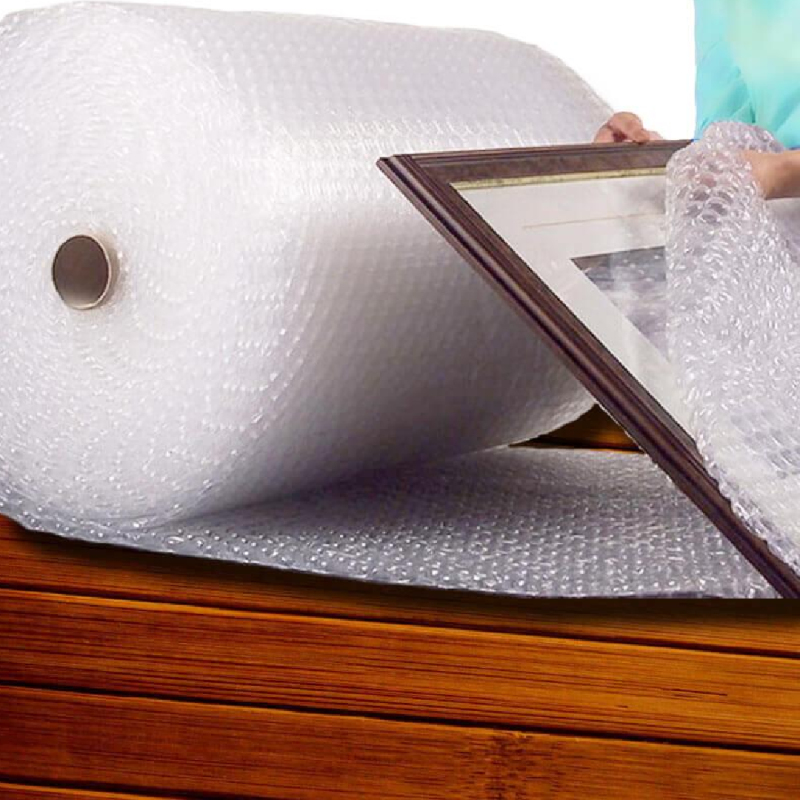
Item Code:
21868923568dBrand:
Bubble wrap, also known as bubble roll, is a pliable transparent plastic material used for packing fragile items. Regularly spaced, protruding air-filled hemispheres (bubbles) provide cushioning for fragile items. The material was invented in 1957 by engineers Alfred Fielding and Marc Chavannes in Hawthorne, New Jersey. Although initially conceived as a new type of wallpaper, the product found its true calling as a protective packaging material.
The standard bubble wrap manufacturing process involves trapping air bubbles between two layers of polyethylene film. One layer is flat while the other has the bubble-shaped indentations. The material comes in various bubble sizes and film thicknesses to accommodate different packaging needs. Small bubbles work well for lightweight items, while larger bubbles provide more cushioning for heavier objects.
Bubble wrap has an interesting origin story that begins with a failed attempt at creating textured wallpaper. In 1957, engineers Alfred Fielding and Marc Chavannes were trying to develop a plastic wallpaper with a textured surface. They sealed two shower curtains together, trapping air bubbles in between. While their wallpaper idea didn't take off, they soon realized their invention had potential as a packaging material.
In 1960, Fielding and Chavannes founded the Sealed Air Corporation to market their new product. The first major client was IBM, which used bubble wrap to protect its delicate computer components during shipping. This successful application helped establish bubble wrap as a reliable packaging solution. Over the decades, the product evolved with different bubble sizes, anti-static varieties, and even biodegradable options.
The effectiveness of bubble wrap lies in its simple yet brilliant design. The air-filled bubbles act as tiny cushions that absorb and distribute impact energy. When pressure is applied to the material, the air inside the bubbles compresses, reducing the force transferred to the protected item. This cushioning effect helps prevent damage from shocks, vibrations, and minor impacts during transportation.
For optimal protection, bubble wrap should be used with the bubbles facing toward the item being packaged. This direct contact allows the bubbles to absorb impacts most effectively. Multiple layers may be needed for extremely fragile items. The material can be wrapped around objects or used as void fill in shipping boxes to prevent items from shifting during transit.
Not all bubble wrap is created equal. Manufacturers produce various types to meet specific packaging needs. Standard bubble wrap typically has bubbles measuring 1/4 inch to 1/2 inch in diameter. Anti-static bubble wrap is essential for protecting sensitive electronic components from electrostatic discharge. This specialized version has a coating that prevents static electricity buildup.
For heavier items, large-bubble wrap with diameters up to 1 inch provides enhanced cushioning. Some bubble wrap features self-adhesive strips for easier application. Perforated bubble wrap allows for easy tearing to desired sizes. Environmentally conscious options include biodegradable bubble wrap made from recycled materials or alternative polymers that break down more quickly in landfills.
While primarily designed for packaging, bubble wrap has found numerous alternative applications. Its satisfying popping sound has made it a popular stress-relief tool. Some people find the tactile experience of popping bubble wrap bubbles therapeutic. Artists have incorporated bubble wrap into their works, using it to create unique textures in paintings or as a printing tool.
In gardening, bubble wrap can insulate plants from frost damage. Greenhouses sometimes use it as an additional layer of insulation during colder months. Bubble wrap has even been used in clothing, with designers creating garments that incorporate the material for its unique texture and insulating properties. These creative applications demonstrate the material's versatility beyond its original purpose.
As a plastic product, bubble wrap raises environmental concerns. Traditional polyethylene bubble wrap is not biodegradable and can persist in landfills for centuries. However, the industry has responded with more sustainable options. Many manufacturers now produce bubble wrap using recycled materials. Some companies offer reusable bubble wrap that can be used multiple times before recycling.
Biodegradable alternatives made from cornstarch or other plant-based materials are becoming more available. These break down much faster than conventional plastic. Consumers can also reduce environmental impact by reusing bubble wrap for multiple shipments or repurposing it for insulation or craft projects. Proper recycling through plastic film collection programs helps keep bubble wrap out of landfills.